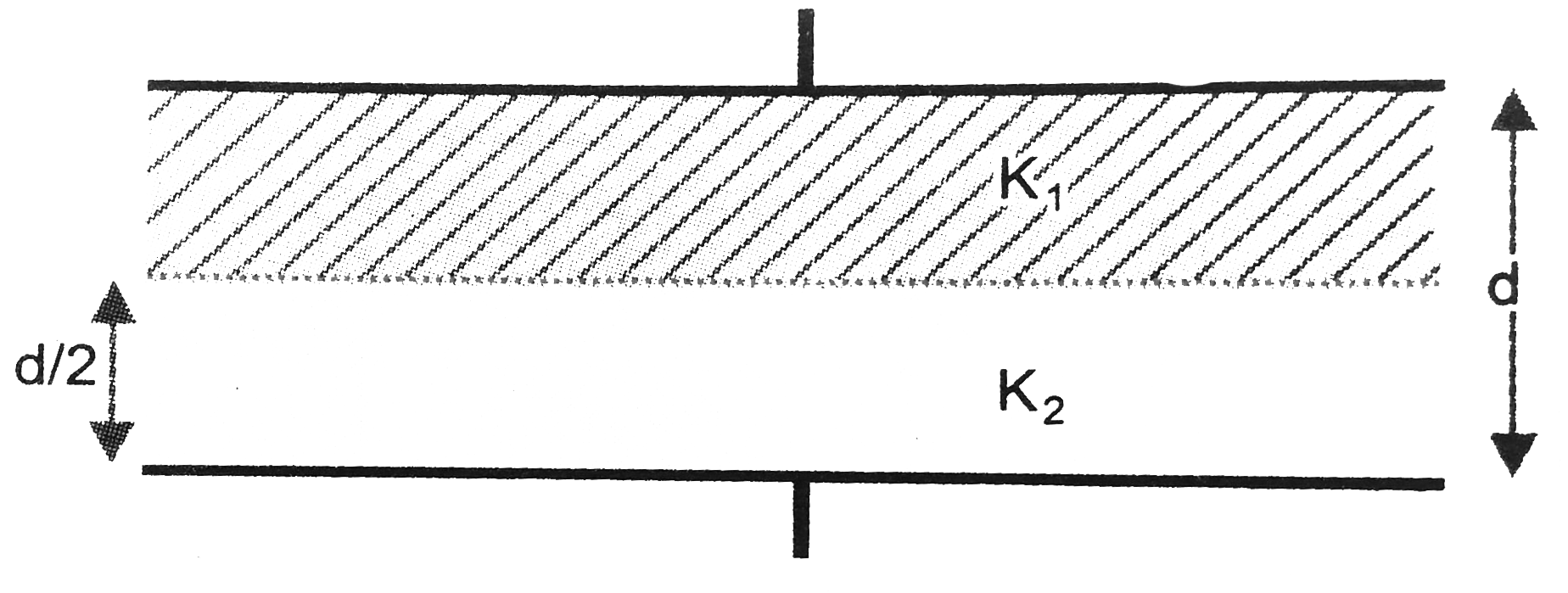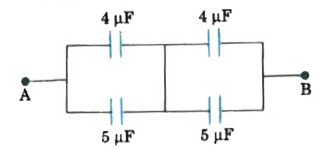Two capacitors of capacitance C are connected in series. If one of them is filled with dielectric substance K, what is the effective capacitance?
KC(1+K)
C(K+1)
2KC1+K
None of the above
The correct Answer is:A
To find the effective capacitance of two capacitors connected in series, where one of them is filled with a dielectric substance of dielectric constant K, we can follow these steps:
Step 1: Identify the capacitance of the capacitors
Let the capacitance of the first capacitor (without dielectric) be C1=C and the capacitance of the second capacitor (with dielectric) be C2. The capacitance of a capacitor filled with a dielectric is given by:
C2=K⋅C
Step 2: Write the formula for effective capacitance in series
For two capacitors in series, the formula for the effective capacitance Ceff is given by:
1Ceff=1C1+1C2
Step 3: Substitute the values of C1 and C2
Substituting C1 and C2 into the formula:
1Ceff=1C+1K⋅C
Step 4: Simplify the equation
To simplify the right-hand side, we can find a common denominator:
1Ceff=K+1K⋅C
Step 5: Invert to find Ceff
Now, we can invert both sides to solve for Ceff:
Ceff=K⋅CK+1
Final Answer
Thus, the effective capacitance of the two capacitors in series, with one filled with a dielectric substance, is:
Ceff=K⋅CK+1
---
Let the capacitance of the first capacitor (without dielectric) be C1=C and the capacitance of the second capacitor (with dielectric) be C2. The capacitance of a capacitor filled with a dielectric is given by:
For two capacitors in series, the formula for the effective capacitance Ceff is given by:
Substituting C1 and C2 into the formula:
To simplify the right-hand side, we can find a common denominator:
Now, we can invert both sides to solve for Ceff:
Thus, the effective capacitance of the two capacitors in series, with one filled with a dielectric substance, is:
Topper's Solved these Questions
- ELECTROSTATICSBOOK - MHTCET PREVIOUS YEAR PAPERS AND PRACTICE PAPERSCHAPTER - ELECTROSTATICSEXERCISE - MHT CET Corner
29 Videos
- ELECTROSTATICSBOOK - MHTCET PREVIOUS YEAR PAPERS AND PRACTICE PAPERSCHAPTER - ELECTROSTATICSEXERCISE - PRACTICE EXERCISE (Exercise 1 (TOPICAL PROBLEMS))
87 Videos
- ELECTRONS AND PROTONSBOOK - MHTCET PREVIOUS YEAR PAPERS AND PRACTICE PAPERSCHAPTER - ELECTRONS AND PROTONSEXERCISE - MHT CET CORNER
19 Videos
- FORCEBOOK - MHTCET PREVIOUS YEAR PAPERS AND PRACTICE PAPERSCHAPTER - FORCEEXERCISE - Exercise 2 (Miscellaneous Problems)
19 Videos
Similar Questions
Knowledge Check
Two capacitors of capacitance C are connected in series. If one of them is filled with dielectric substance K, what is the effective capacitance?
AKC(1+K)BC(K+1)C2KC(1+K)DNone of theseThree identical capacitors each of capacitance C are connected in series and this connection is connected in parallel with one such more identical capacitor. Then, the capacitance of the whole combination is
A3CB4C/3C3C/4D2CA parallel plate capacitor is filled with dielectrics. What is capacitance?
 A2K1K2K1+K2BK1K2K1+K2C2ε0Ad(K1K2K1+K2)D2ε0Ad(2K1+K22K1K2)
A2K1K2K1+K2BK1K2K1+K2C2ε0Ad(K1K2K1+K2)D2ε0Ad(2K1+K22K1K2)
Two capacitors of equal capacitance when connected in series hae net capacitance C1 and when connected in parallel have net capacitance C2 what is the value of C1/C2?
View SolutionA parallel plate capacitor is filled with dielectrics as shown in Fig. What is its capacitance ?

View SolutionAn infinite number of capacitors of capacitance C, 4C, 16C.... ∞ are connected in series. If Ceq will be their resultant capacitance, then find (CeqC)
View SolutionTwo parallel plate capacitors, each of capacitance 40 muF, are connected is series. The space between the plates of one capacitor is filled with a dielectric material of dielectric constant K =4. Find the equivalent capacitacne of the system.
View SolutionThree capacitor of capacitance C(μF) are connected in parallel to which a capacitor of capacitance C is connected in series. Effective capacitance is 3.75. then capacity off each capacitor is
View Solution
